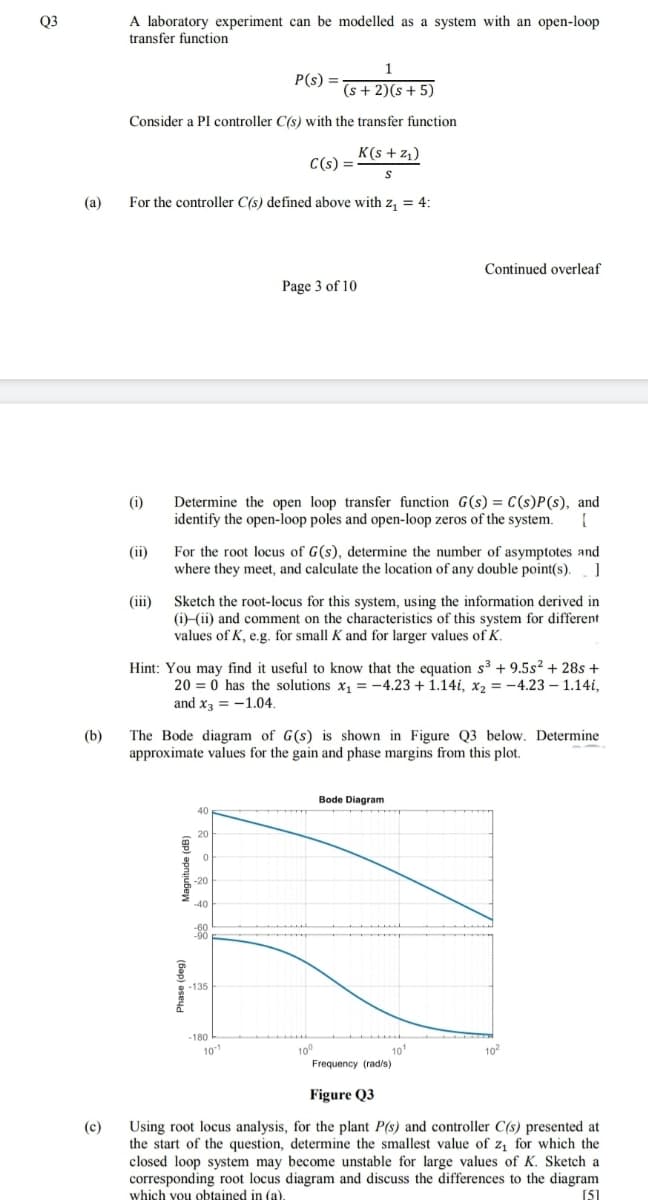A laboratory experiment can be modelled as a system with an open-loop transfer function Q3 1 P(s) (s + s)(Z + s) Consider a PI controller C(s) with the transfer function K(s + z1) C(s) (a) For the controller C(s) defined above with z, = 4: Continued overleaf Page 3 of 10 Determine the open loop transfer function G(s) = C(s)P(s), and identify the open-loop poles and open-loop zeros of the system. (i) (ii) For the root locus of G(s), determine the number of asymptotes and where they meet, and calculate the location of any double point(s). 1 (iii) Sketch the root-locus for this system, using the information derived in (i)-(ii) and comment on the characteristics of this system for different values of K, e.g. for small K and for larger values of K. Hint: You may find it useful to know that the equation s3 + 9.5s2 + 28s + 20 = 0 has the solutions x, = -4.23 + 1.14i, x2 = -4.23 - 1.14i, and x3 = -1.04.
A laboratory experiment can be modelled as a system with an open-loop transfer function Q3 1 P(s) (s + s)(Z + s) Consider a PI controller C(s) with the transfer function K(s + z1) C(s) (a) For the controller C(s) defined above with z, = 4: Continued overleaf Page 3 of 10 Determine the open loop transfer function G(s) = C(s)P(s), and identify the open-loop poles and open-loop zeros of the system. (i) (ii) For the root locus of G(s), determine the number of asymptotes and where they meet, and calculate the location of any double point(s). 1 (iii) Sketch the root-locus for this system, using the information derived in (i)-(ii) and comment on the characteristics of this system for different values of K, e.g. for small K and for larger values of K. Hint: You may find it useful to know that the equation s3 + 9.5s2 + 28s + 20 = 0 has the solutions x, = -4.23 + 1.14i, x2 = -4.23 - 1.14i, and x3 = -1.04.
Introductory Circuit Analysis (13th Edition)
13th Edition
ISBN:9780133923605
Author:Robert L. Boylestad
Publisher:Robert L. Boylestad
Chapter1: Introduction
Section: Chapter Questions
Problem 1P: Visit your local library (at school or home) and describe the extent to which it provides literature...
Related questions
Question

Transcribed Image Text:A laboratory experiment can be modelled as a system with an open-loop
transfer function
Q3
1
P(s) =
(s + 2)(s + 5)
Consider a PI controller C(s) with the transfer function
K(s + z1)
C(s) =
(a)
For the controller C(s) defined above with z, = 4:
Continued overleaf
Page 3 of 10
Determine the open loop transfer function G(s) = C(s)P(s), and
identify the open-loop poles and open-loop zeros of the system.
(i)
For the root locus of G(s), determine the number of asymptotes and
where they meet, and calculate the location of any double point(s).
(ii)
Sketch the root-locus for this system, using the information derived in
(i)-(ii) and comment on the characteristics of this system for different
values of K, e.g. for small K and for larger values of K.
(iii)
Hint: You may find it useful to know that the equation s3 + 9.5s² + 28s +
20 = 0 has the solutions x, = -4.23 + 1.14i, x2 = -4.23 – 1.14i,
and x3 = -1.04.
(b)
The Bode diagram of G(s) is shown in Figure Q3 below. Determine
approximate values for the gain and phase margins from this plot.
Bode Diagram
40
20
-40
-135
-180
10
100
10'
102
Frequency (radis)
Figure Q3
Using root locus analysis, for the plant P(s) and controller C(s) presented at
the start of the question, determine the smallest value of z, for which the
closed loop system may become unstable for large values of K. Sketch a
corresponding root locus diagram and discuss the differences to the diagram
which you obtained in (a).
(c)
[51
(Gap) aseyd
Expert Solution
This question has been solved!
Explore an expertly crafted, step-by-step solution for a thorough understanding of key concepts.
Step by step
Solved in 5 steps with 1 images

Knowledge Booster
Learn more about
Need a deep-dive on the concept behind this application? Look no further. Learn more about this topic, electrical-engineering and related others by exploring similar questions and additional content below.Recommended textbooks for you

Introductory Circuit Analysis (13th Edition)
Electrical Engineering
ISBN:
9780133923605
Author:
Robert L. Boylestad
Publisher:
PEARSON

Delmar's Standard Textbook Of Electricity
Electrical Engineering
ISBN:
9781337900348
Author:
Stephen L. Herman
Publisher:
Cengage Learning

Programmable Logic Controllers
Electrical Engineering
ISBN:
9780073373843
Author:
Frank D. Petruzella
Publisher:
McGraw-Hill Education

Introductory Circuit Analysis (13th Edition)
Electrical Engineering
ISBN:
9780133923605
Author:
Robert L. Boylestad
Publisher:
PEARSON

Delmar's Standard Textbook Of Electricity
Electrical Engineering
ISBN:
9781337900348
Author:
Stephen L. Herman
Publisher:
Cengage Learning

Programmable Logic Controllers
Electrical Engineering
ISBN:
9780073373843
Author:
Frank D. Petruzella
Publisher:
McGraw-Hill Education

Fundamentals of Electric Circuits
Electrical Engineering
ISBN:
9780078028229
Author:
Charles K Alexander, Matthew Sadiku
Publisher:
McGraw-Hill Education

Electric Circuits. (11th Edition)
Electrical Engineering
ISBN:
9780134746968
Author:
James W. Nilsson, Susan Riedel
Publisher:
PEARSON

Engineering Electromagnetics
Electrical Engineering
ISBN:
9780078028151
Author:
Hayt, William H. (william Hart), Jr, BUCK, John A.
Publisher:
Mcgraw-hill Education,